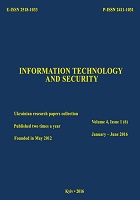Evaluation of energy availability of means to communicate with UAVs in conditions of radioelectronic countermeasures by the enemy
DOI:
https://doi.org/10.20535/2411-1031.2016.4.1.96122Keywords:
Unmanned aerial vehicle (UAV), radio signal, coefficient of radio suppression, wideband modulation system, energy efficiency, radio-electronic warfare.Abstract
During the research the calculations of noise immunity indicators and energy availability of means to communicate with unmanned aerial vehicles according to the reviewed in this article algorithms, based on the analysis of both operational and combat indicators of opposing troops building in the area of anti-terrorist operation in eastern Ukraine, and tactical and technical characteristics of examined means of communication and radio-electronic warfare. The real work fully achieved the goal to assess the possibilities of effective functioning of the reviewed radio communication systems in conditions of full active use of radio countermeasure systems and means of radio-electronic warfare, taking into account all applicable noise protection measures. Based on the data calculations it is expedient to deploy UAV’s control systems with the implementation of noise stability means of radio communication, built according to the reviewed principles of wideband communication systems using measures of protection against noise, mainly of signal character, that most effectively improves the noise immunity indicators. The developed algorithms, in case of software implementation, can be used as a final product to enhance the degree of automation and promptness during the calculation of the efficiency of radio communication means in condition of opponent`s radio countermeasures. The results, received during the study, can be used in assessing noise immunity and energy availability of existing and future (prospective) means of radio communication.
References
M.I. Maimistov, “The complex to combat small-sized unmanned aerial vehicles”. [Online]. Available: http://ntc-reb.ru/article10.html. Accessed on: Dec. 15, 2016.
V.A. Azov, “The battalions of intelligence and REW divisions of the US Army”, ZVO, iss. 2, pp. 20-24, 1998.
V.A. Babul, I.M. Bykov, V.V. Gordei, A.G. Lukashevich, and V.L. Rzhevusskii. Fundamentals of Electronic Warfare in the Missile Forces. Minsk, Belarus: Military Academy of Belarus, 2000.
V.V. Gordei, and V.L. Rzhevusskii. Fundamentals of energy calculations of radio communication suppression. Minsk, Belarus: Military Academy of Belarus, 2004.
I.A. Semashko, A.N. Bobovik, and S.G. Golubtsov. Basics of communication organization. Minsk, Belarus: UO VORB, 2004.
M.P. Dolukhanov. Radiowave propagation. Moscow, Russia: Sviaz, 1965.
Y. Toropchyn, et al. Handbook of air defense. Kyiv, Kharkiv, Ukraine: Ministry of Defence Ukraine, KHVU, 2003.
I.P. Melnikov. Aerial radio-electronic intelligence (performance assessment methods). Moscow, Russia: Radiotekhnika, 2005.
B.A. Nikolskii. Fundamentals of radio systems. Samara, Russia: Samara State Aerospace University (National Research University), 2013.
Downloads
Published
How to Cite
Issue
Section
License
Copyright (c) 2020 Collection "Information technology and security"

This work is licensed under a Creative Commons Attribution 4.0 International License.
The authors that are published in this collection, agree to the following terms:
- The authors reserve the right to authorship of their work and pass the collection right of first publication this work is licensed under the Creative Commons Attribution License, which allows others to freely distribute the published work with the obligatory reference to the authors of the original work and the first publication of the work in this collection.
- The authors have the right to conclude an agreement on exclusive distribution of the work in the form in which it was published this anthology (for example, to place the work in a digital repository institution or to publish in the structure of the monograph), provided that references to the first publication of the work in this collection.
- Policy of the journal allows and encourages the placement of authors on the Internet (for example, in storage facilities or on personal web sites) the manuscript of the work, prior to the submission of the manuscript to the editor, and during its editorial processing, as it contributes to productive scientific discussion and positive effect on the efficiency and dynamics of citations of published work (see The Effect of Open Access).

